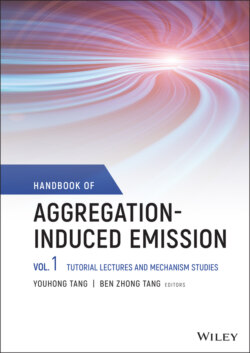Читать книгу Handbook of Aggregation-Induced Emission, Volume 1 - Группа авторов - Страница 36
2.3.3 Bending Vibration of Bonds
Оглавление(CAACAd)CuCl (see Figure 2.3) is a two‐coordinate Cu(I) complex, which exhibits highly efficient fluorescence in aggregate [50]. The excited‐state decay dynamics for (CAACAd)CuCl in both solution and solid states is studied by the hybrid QM/MM approach, coupled with the TVCF rate formalism [42]. Analyzing the geometrical changes between S0 and S1 upon excitation, it is found that the complex is more flexible in solution. The largest changes appear in the coordination bond angles between copper and two ligands with ∠C1−Cu−Cl, ∠Cu−C1−N, and ∠Cu−C1−C4 decreasing from 9.67°, 12.82°, and 10.73° in solution to 3.66°, 4.46°, and 6.75° in the solid phase, respectively. And the transition character changes from metal‐to‐ligand charge transfer (MLCT) to hybrid MLCT and halogen‐to‐ligand charge transfer (XLCT) upon aggregation. The kr are close in both phases, while kic decreases by about 3 orders of magnitude from 8.38 × 107 to 1.47 × 104 s−1 (see Table 2.2). The λtotal decreases a lot from solution (7121 cm−1) to solid state (2274 cm−1). It is found that the largest contributions to λtotal come from several low‐frequency bending modes and one high‐frequency stretching mode in solution. These low‐frequency modes are assigned to be the bending vibrations associated with coordination bonds C1−Cu and Cu−Cl, and the high‐frequency mode belongs to the stretching vibration of the C−N bond in carbene ligand. Upon aggregation, the vibrations of angles C1−Cu−Cl and Cu–C1–N are restricted largely, while the stretching vibrations of the C1−N bond are insensitive to the environment (Figure 2.4c). Overall, the strong solid‐state fluorescence of (CAACAd)CuCl is induced by removing the nonradiative decay channels owing to the decoupling between transition electron and the bending vibrations of coordination bonds (see Figure 2.2d).
Figure 2.4 Calculated reorganization energies versus normal mode of (a) HPS, (b) TPA, (c) (CAACAd)CuCl, and (d) COTh in both gas/solution and solid phases, respectively.
